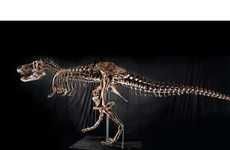
Unearthed Mammal Could Explain the Evolution of Human Hearing
Katherinev123 — October 11, 2009 — World
References: dsc.discovery
The discovery of a fossil of a previously unknown chipmunk-sized mammal in northeastern China could potentially explain the evolution of human hearing.
The 123 million year-old fossil, now referred to as the Maotherim asiaticus, is just five inches long but remarkably preserved. According to Discovery.com, this allows the researchers to reconstruct how the creature’s middle ear was connected to its jaw—information that could help to explain the mystery of a high-performance hearing system.
As hearing is so fundamental to a mammal’s—and human’s—way of life, the study of its development is of great importance to researchers. Here's what Professor Zhe-Xi Luo, a curator at the Carnegie Museum of Natural History in Pittsburgh and one of the study’s authors, had to say about the findings:
While the finding is significant, Discovery.com points out that “the ear connection could simply be a adaptation caused by changes in development, rather than an evolutionary link,” and that the unearthed creature may not fit into the evolutionary chain at all.
The 123 million year-old fossil, now referred to as the Maotherim asiaticus, is just five inches long but remarkably preserved. According to Discovery.com, this allows the researchers to reconstruct how the creature’s middle ear was connected to its jaw—information that could help to explain the mystery of a high-performance hearing system.
As hearing is so fundamental to a mammal’s—and human’s—way of life, the study of its development is of great importance to researchers. Here's what Professor Zhe-Xi Luo, a curator at the Carnegie Museum of Natural History in Pittsburgh and one of the study’s authors, had to say about the findings:
What is most surprising, and thus scientifically interesting, is the animal's inner ear... The development of the ear is seen as key to understanding survival techniques that steered mammals, including human ancestors, through the dinosaur-infested mesozoic period around 250 to 66 million years ago."
While the finding is significant, Discovery.com points out that “the ear connection could simply be a adaptation caused by changes in development, rather than an evolutionary link,” and that the unearthed creature may not fit into the evolutionary chain at all.
Trend Themes
1. Evolution of Human Hearing - The discovery of the Maotherium asiaticus fossil could offer insights into the evolutionary development of human hearing, presenting opportunities for disruptive innovation in audiology and hearing aid technologies.
2. Preservation of Fossils - The remarkable preservation of the Maotherium asiaticus fossil opens up possibilities for disruptive innovation in paleontological methods and techniques, allowing for more accurate reconstruction and analysis of ancient animal features.
3. Importance of Inner Ear Development - The significance of the inner ear development in mammals, highlighted by the Maotherium asiaticus discovery, presents opportunities for disruptive innovation in medical research and treatments related to hearing loss and inner ear disorders.
Industry Implications
1. Audiology - The findings of the Maotherium asiaticus fossil discovery offer potential disruptive innovation opportunities in audiology, leading to the development of new hearing technologies and treatment methods.
2. Paleontology - The exceptional preservation of the Maotherium asiaticus fossil provides disruptive innovation opportunities in the field of paleontology, enabling improved techniques for fossil analysis and reconstruction.
3. Medical Research - The importance of inner ear development, highlighted by the Maotherium asiaticus discovery, presents possibilities for disruptive innovation in medical research focused on advancements in hearing-related treatments and therapies.
2.2
Score
Popularity
Activity
Freshness























